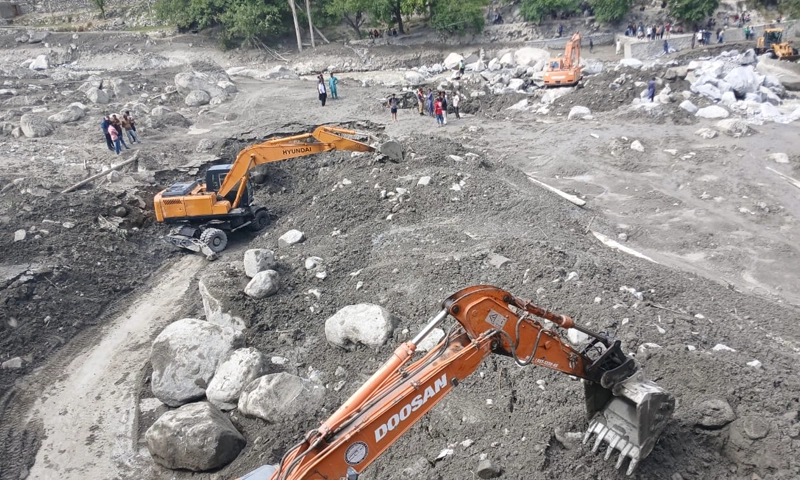- Web Desk
- 38 Minutes ago
Continuous floods bring life to a grinding halt in G-B
-
- Tanveer Abbas Web Desk
- Aug 16, 2025

Gilgit: Unprecedented floods, driven by climate change, have brought life to a standstill in Gilgit-Baltistan as raging waters washed away critical bridges and roads across the region.
According to the Gilgit-Baltistan Disaster Management Authority (GBDMA), several key bridges—including the Surmro Bridge, Haldi Bridge in Ghanche, Saltoro River Bridge in Shigar, and Baghecha Bridge in Skardu — have been severely damaged.
Major road closures have been reported across the region. The Jaglot-Skardu Road is blocked at Astak, Chamchu, and Shangus, while the Ghizer Road is obstructed at Dain and Khalti.
The Babusar Top Road remains closed at multiple points, and the Karakoram Highway is blocked in Kohistan, Danyore, Jaglot, and Gojal (Hunza). Flash floods also swept away the Naltar Expressway, cutting off access to upper Naltar. Similar road closures reported in Astore, Nagar, Haramosh, Bagrote, and Hunza. The Mashabrum Road is blocked near Haldi in Ghanche, and the route to Hoper Valley in Nagar has been severed due to a collapsed bridge.
Widespread Infrastructure and Property Damage
The GBDMA’s latest report highlights severe flooding in Ghuwachi Nullah (Gilgit), which partially diverted the Hunza River toward Guru Jaglot, causing erosion and putting 22 houses at risk. Government fish farms, hotels, and agricultural land have also been damaged. In Oshikhandas, the main water channel was destroyed at three points, disrupting drinking water and irrigation supplies.
Also read: Flash floods devastate Buner as KP death toll crosses 330
In Skardu, debris blocked the Astak Bridge on Saturday evening, leaving 13–15 vehicles stranded between Astak and Dambudas, with a similar number trapped between Astak and Chamachu. The Baghicha RCC Bridge was also damaged, with a 40-foot section washed away.
Diamer District suffered extensive road damage, including the destruction of a 200-foot stretch of the Thore Valley Road, 850 feet of road and two bridges in Darel, and 11 kilometers of road in Bunar Valley. The Bunner Powerhouse was damaged, and the Thak–Babusar transmission line was disrupted.
Floods in Ghizer’s Damas, Hatoon Dass, and Silpi areas have destroyed homes, farmland, and orchards. Ghanche District reported significant damage to power stations.
In Astore, a flash flood in Maikiyal Nullah wiped out 250 meters of the Chilam Road, along with agricultural land, water supply systems, and irrigation channels. Low-level floods were also reported in Harcho Nullah and Kushunat.
Widespread blackouts have been reported across Gilgit-Baltistan as transmission lines and power stations sustained significant damage. Gilgit City has been without electricity for more than 50 hours after floodwaters disrupted water intake to three powerhouses in Naltar.
The GBDMA confirmed that at least 35 people have died, 35 others have been injured, and four remain missing since the start of the monsoon season. Additionally, 318 houses were completely destroyed, while 674 suffered partial damage.
Meanwhile, the Pakistan Meteorological Department (PMD) has warned that monsoon rains are likely to intensify from August 17 onwards. Strong monsoon currents from the Arabian Sea and Bay of Bengal are continuously penetrating the country, with a low-pressure system over the Bay of Bengal expected to move westward and intensify monsoon activity.
The PMD said that widespread rain-wind/thundershower – with scattered heavy falls and at times very heavy – is expected in Neelum Valley, Muzaffarabad, Rawalakot, Poonch, Hattian, Bagh, Haveli, Sudhanoti, Kotli, Bhimber, and Mirpur in Kashmir; and Diamir, Astore, Ghizer, Skardu, Hunza, Gilgit, Ghanche, and Shigar in Gilgit-Baltistan from August 17 to 19, with occasional gaps.
It predicted a similar situation for Dir, Chitral, Swat, Kohistan, Shangla, Battagram, Mansehra, Abbottabad, Haripur, Buner, Malakand, Bajaur, Mohmand, Kohat, Peshawar, Charsadda, Nowshera, Mardan, Swabi, Khyber, Orakzai, Kurram, Hangu, Karak, Bannu, Lakki Marwat, Waziristan, Tank, and Dera Ismail Khan in Khyber Pakhtunkhwa during the same period.
It said that similar rains are expected in Islamabad/Rawalpindi, Murree, Galliyat, Attock, Chakwal, Jhelum, Mandi Bahauddin, Gujrat, Gujranwala, Hafizabad, Wazirabad, Lahore, Kasur, Sheikhupura, Sialkot, Narowal, Mianwali, Khushab, Sargodha, Jhang, Toba Tek Singh, Nankana Sahib, Chiniot, Faisalabad, and Sahiwal.
Mithi, Tharparkar, Umer Kot, Mirpurkhas, Hyderabad, Shaheed Benazirabad, Karachi, Thatta, Badin, Sajawal, Tando Allayar, Tando Muhammad Khan, Sanghar, Jamshoro, Sukkur, Larkana, Khairpur, and Jacobabad in Sindh; and Barkhan, Musakhel, Loralai, Sibbi, Zhob, Qilla Saifullah, Khuzdar, Lasbela, Awaran, Kech, Gwadar, and Panjgur in Balochistan will also experience such rains during the period.





